To help you select the right GPU for your build, we have decided to write down an in-depth RX 7900 XTX vs RTX 3080 Ti guide. We are going to see how these two are different from each other and the kind of performance difference you can expect from them in games.
Key Takeaways
- Radeon RX 7900 XTX is a high-end GPU from AMD’s RDNA 3 lineup, whereas Geforce RTX 3080 Ti is a high-end GPU from Nvidia’s previous Ampere architecture.
- RX 7900 XTX is roughly 20 to 50% better in games compared to RTX 3080 Ti
- Both GPUs have a very similar TDP and require a PSU of at least 750 watts.
- 7900 XTX has twice the VRAM at around 24 GB compared to 12 GB of 3080 Ti.
- RX 7900 XTX is approximately 18% cheaper than RTX 3080 Ti was at MSRP.
RX 7900 XTX Vs RTX 3080 Ti: Comparison Table
| Specs | Radeon RX 7900 XTX | RTX 3080 TI |
| Architecture | RDNA 3 | Ampere |
| GPU Name | NAVI 31 XTX | GA 102 |
| Foundry | TSMC 5 nm | Samsung 8 nm |
| Base Clock Speed | 1855 MHz | 1365 MHz |
| Boost Clock Speed | 2499 MHz | 1665 MHz |
| Memory Capacity | 24 GB GDDR6 | 12 GB GDDR6X |
| Memory Interface Speed | 2500 MHz | 1188 MHz |
| Bus Interface | PCIe 4.0 x16 | PCIe 4.0 x16 |
| Thermal Design Power (TDP) | 355 Watts | 350 Watts |
| No. of transistors | 57,700 million | 28,300 million |
| RT Cores | 96 | 80 |
| TMUs | 384 | 320 |
| Price | 999 USD | 1,199 USD |
| Release Date | Nov 3rd, 2022 | May 31st, 2021 |
| Best Variants | Best RX 7900 XTX Cards | Best RTX 3080 Ti Cards |
Differences In Specifications
On paper, it is pretty apparent that the AMD’s greatest, 7900 XTX, absolutely knocks 3080 Ti out of the park. The newer RDNA 3 is simply too much for Nvidia’s former Ampere architecture.
Also Read: RX 7900 XT Vs RTX 3080 Ti
We can see that 7900 XTX has a whopping 15.7% more Cuda cores compared to 3080 Ti. AMD cards suffered in this regard previously against Nvidia as they struggled to match the core count, but things took a drastic turn here as AMD managed to put 12288 Cuda cores in their beast. 3080 Ti, on the other hand, could only work around 10496 Cuda cores. This means users of 7900 XTX will have an edge in parallel processing due to the superior number of Cuda cores.
7900 XTX can also run at faster base clock speeds of around 1900 MHz. 3080 Ti, on the other hand, maxes out at 1365 MHz. This goes to show that the 7900 XTX is able to run at whopping 32.7% faster clock speeds compared to the 3080 Ti. Boost clock speeds are no different, either. This time around, 7900 XTX is able to run at 2500 MHz. Contrary to that, 3080 Ti can run at a maximum of 1800 MHz, giving Team Red a 32.5% lead.
Another aspect where 3080 Ti does not stand a chance against 7900 XTX is memory capacity. 7900 XTX boasts a solid 24 GB VRam, whereas the 3080 Ti has half of it, at 12 GB. This allows developers more creative freedom with their work while also future-proofing their rigs. To 3080 Ti’s credit, it does have a slightly faster GDDR6X memory, whereas 7900 XTX has regular GDDR6 memory. The newer GDDR6X memory is marginally more power-efficient and faster, but both are extremely capable of handling games at 4K resolution.
The older ampere architecture has started showing its age next to AMD’s latest RDNA 3 lineup. 3080 Ti is based on that older 8 nm architecture, whereas 7900 XTX is based on the smaller 5 nm TSMC chip. What’s even more impressive is that AMD could fit 57,700 million transistors on the more minor 5nm chip. Contrary to that, folks over at Nvidia could only put 28,300 million transistors on their more giant 8 nm chip. AMD managed to put 68.3% more transistors on a minor chip than Nvidia.
7900 XTX has a slightly higher TDP at around 355 watts, whereas 3080 Ti’s TDP was about 350 watts. However, recommended PSU for both GPUs is about 750 watts. Perhaps the most significant difference between both is the price. 7900 XTX was launched at a highly competitive price of 999 USD. Compared to that, the 3080 Ti was launched for 1199 USD. That is a whopping 18% increase in price compared to 7900 XTX. Also, you might want to check out our RX 7900 XTX vs RX 6900 XT comparison.
DLSS Vs FSR
Both Nvidia and AMD have released their own resolution upscaling techniques to significantly improve the gaming experience for their users by providing them extra fps at the cost of upscaled resolution. Both tech giants use AI to implement this, where the game runs initially at a lower resolution to provide gamers with a much smoother experience by increasing the frame rate significantly.
But running at a lower resolution means that the graphics’ quality takes a significant hit. That’s where AI comes in. Both uses AI to upscale the previously degraded resolution to make the game look as good as possible and also make the users think that they are running the game at native resolution while also providing them with a much more stable experience.
Though both lineups can handle games at their recommended resolutions, this upscaling practice is very handy when ray tracing is applied. Upon applying ray tracing, the game’s visuals are significantly cranked up with reflective surfaces and glossy reflections all over the scene. However, with this, the performance also takes a hit, and the game’s frame rate decreases significantly. That’s where upscaling techniques come to the rescue, ensuring the game looks visually stunning while maintaining a smoother frame rate.
Nvidia DLSS
Nvidia came to the upscaling party way earlier than AMD did with their Deep Learning Super Sampling, or simply DLSS. With a little bit of AI magic and an introduction of tensor cores to their 20X0 lineup (previously only available on their rendering and AI GPUs), Nvidia managed to bring what can be fairly called a disruption to the GPU market.
DLSS managed to pull off minimal quality reduction while also providing a significant boost to a game’s frame rate. This was nothing short of revolutionary. Gamers could crank up their settings to the max while maintaining a stable frame rate. The upscaling method has worked like a charm for the tech giants and was well-received throughout the community.

DLSS 1.0 Vs DLSS 2.0
Nvidia has also been constantly updating this technology. With every newly released lineup of GPUs, Nvidia also provided a much more advanced version of their DLSS. DLSS 1.0 launched with the release of its 20X0 lineup, and DLSS 2.0 with the 30X0 lineup.
The only downside to this is that DLSS is not open source. This means not only is it strictly limited to Nvidia’s RTX cards only, but this also means that it is really hard for developers to implement this technology with their games. Not to mention, this can only be done with the help of Nvidia itself. Not only does this make its implementation quite tricky, but it also means that our favorite Indie Game developers will have to join with Nvidia if they want to implement this upscaling technology in their games. This also means that the indie gamers community has been missing out on quite a lot with the release of DLSS.
AMD FSR
Fidelity FX Super Resolution, or FSR, is AMD’s response to Nvidia’s DLSS. Though AMD was slightly late to the party, it was better late than never. Instead of dedicating actual hardware like Nvidia’s tensor cores, AMD went with a totally software-based approach. AMD could depict most of what DLSS did without the cost of additional hardware. This meant that the GPUs that did not have tensor cores could also now experience resolution upscaling. This was a sigh of relief for low-end gamers as it provided additional years to previous-generation cards. Any GPU that could support DirectX 11 was compatible with it. This meant GPUs as old as AMD’s HD 5870, released almost 13 years ago, could also pump up their performance.

Another good thing about AMD’s FSR is that it is open source and is not limited to AMD’s line of cards. Older gen Nvidia cards could also benefit from it. This was a power move from AMD. And since it is open source, game developers don’t have to join hands with AMD in order to implement this technology in their games. AMD managed to kill two birds with one stone here. Not only were they able to bring life back to the indie gaming community, but they also managed to provide the low-end cards with additional years of lifespan.
Which One Is Better?
Since AMD’s FSR is purely based on software and does not require additional hardware, it is expected that the visual quality it maintains is also not on par with Nvidia’s DLSS. However, since it is an open-source program, we are much more likely to see it in a wider range of games and GPUs. Here’s a comparison of both in Marvel’s Avengers.

Performance
The performance difference between both upscaling technologies is little to none. Both provide a decent boost to the game’s frame rates. It all comes down to what settings you play at, what quality you upscale, and what hardware you implement it on.
Image Quality
Since Nvidia has actual hardware dedicated to upscaling only, it is able to maintain a higher image quality. Nvidia’s AI tensor cores and deep neural network is able to process a lot more data compared to AMD’s FSR. Thus, it outperforms it in this aspect. FSR 2.0 did see some major improvements, but Nvidia’s DLSS was too much to take on for AMD.
Hardware Support
Since AMD’s FSR is open source, it can be implemented on a much wider variety of hardware than Nvidia’s DLSS. Basically, anything that can run DirectX11 can also run AMD’s FSR on it. DLSS, on the other hand, required tensor cores to run. This hardware dependency means Nvidia can only run this on a handful of GPUs that meet the hardware requirement. Also, you might be interested in reading our RX 7900 XTX vs RX 6950 XT guide.
Game Support
Again, FSR being an open-source program is a huge win for game developers. It is much easier to integrate games with it. This means we will see AMD’s FSR on a wider variety of games compared to Nvidia’s DLSS, which only seems to work on AAA titles. Indie game developers can also benefit from AMD’s FSR, which wasn’t possible with Nvidia’s DLSS before.
RX 7900 XTX Vs RTX 3080 Ti: Gaming Benchmarks
From what we have seen, it is pretty evident that the 7900 XTX is ahead of the 3080 Ti in more than a few ways. However, it is one thing to be good on paper and another to be good in real-life tasks such as gaming. For this purpose, we will let these GPUs lock horns against each other in some of the latest recent games in two different resolutions. This will give us a better understanding of how these GPUs perform against each other in the task we buy them for, i.e., gaming.
We will head to TheSpyHood’s YouTube channel for the gaming benchmarks. All the titles were tested on maxed-out settings in two different resolutions, i.e., 2160p and 1440p, on the following rig with both CPUs running on stock configuration.
Testing Rig
- CPU: Intel Core i9-13900K
- Motherboard: Asus ROG Strix Z790-E Gaming WIFI
- CPU Cooler: MSI MAG Core Liquid C360 AIO cooler
- GPU 1: AMD Radeon RX 7900 XTX 24GB
- GPU 2: Nvidia Geforce RTX 3080 TI 12 GB
- RAM: 64 GB DDR5 6000 MHz (4*16 GB)
- PSU: 1200 watts Asus ROG Thor Platinum II
Also Check: Nvidia RTX 4080 Vs RTX 3080 Ti
Cyberpunk 2077
Cyberpunk 2077 is one of the heaviest and most demanding games. It is both a CPU and GPU-intensive title.
1440p
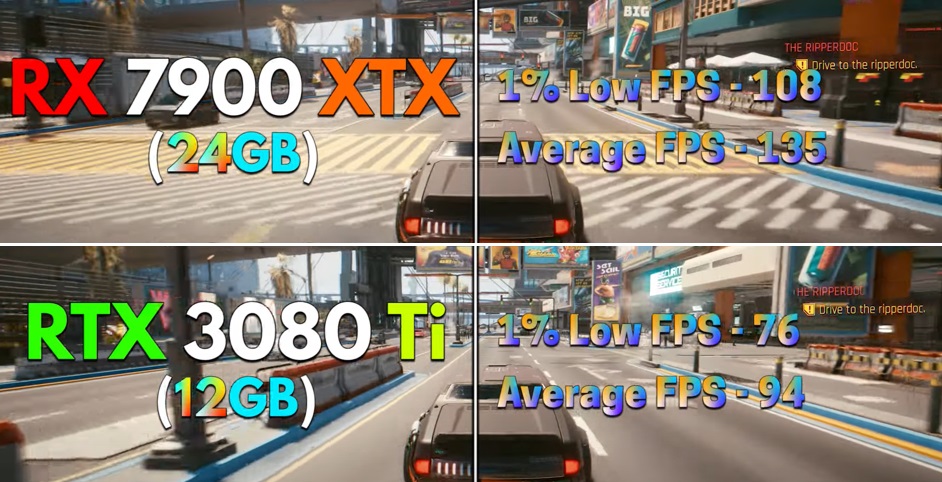
- Right off the bat, we can see that 7900 XTX obliterates 3080 Ti by a whopping margin of 35.8% in average fps at the lower 1440p resolution.
- It consistently offered an average of 135 fps, whereas the 3080 Ti could not even reach triple figures, averaging around 94 fps.
- Even the 1% lows of 7900 XTX were above the average frame rate of 3080 Ti averaging around 108 fps.
- 3080 Ti, on the other hand, was 34.7% behind, averaging around 76 fps.
2160p
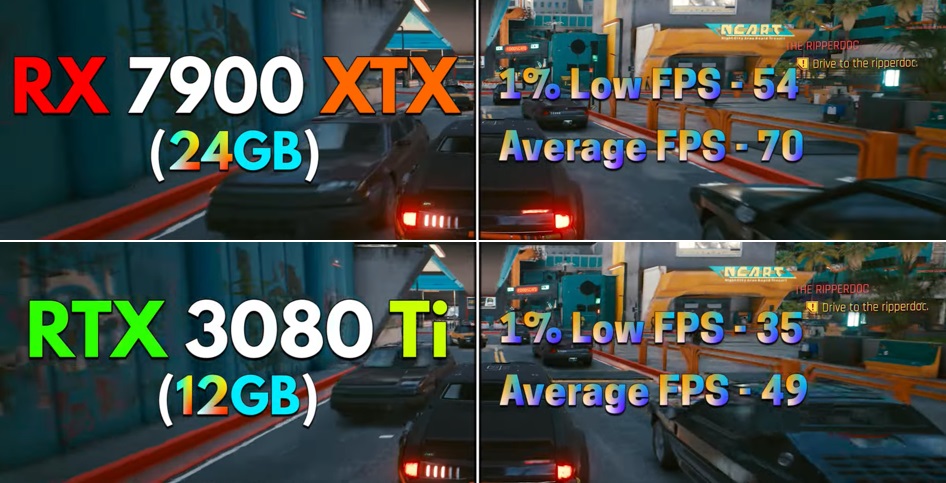
- The higher 2160p saw a similar difference of around 35%, with 7900 XTX coming on top.
- This time around, it managed to give us an average of 70 fps, whereas 3080Ti could not even provide the sweet 4k60 fps experience, averaging around 49 fps.
- The difference in 1% lows was bigger this time, around 42% in favor of 7900 XTX.
- Once again, the 1% lows of 7900 XTX were above the average frame rate of 3080 Ti. It managed to deliver 54 1% low fps, whereas the 3080 Ti could only manage 35 fps.
Horizon Zero Dawn
Horizon Zero Dawn is a little heavier on the GPU than the CPU. It scales really well as we continue to upscale our core count.
1440p
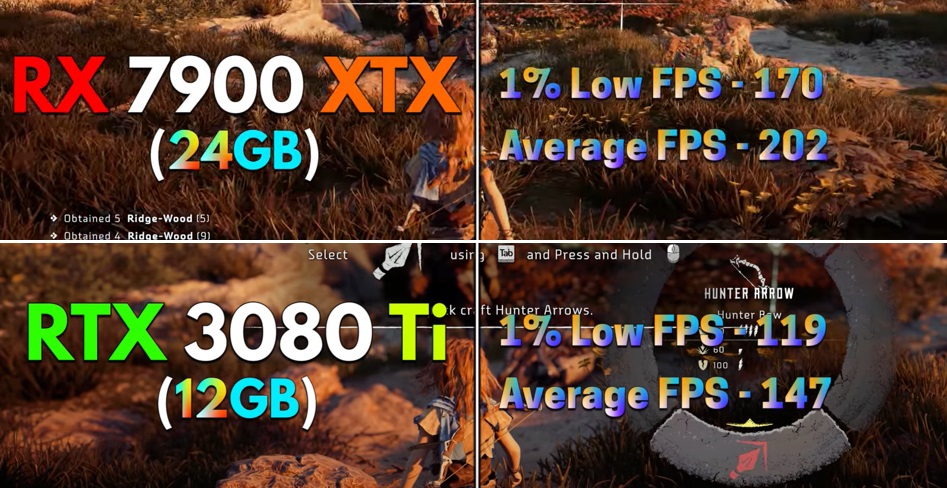
- Horizon Zero Dawn was a little lighter on our GPUs compared to the previous title, as both were giving respectable framerates. However, 7900 XTX is still ahead with a margin of 31%.
- It even broke the 200 fps barrier, averaging around 202 fps. 3080 Ti struggled to cross the 150 fps mark, delivering an average of 147 fps.
- 1% lows saw a similar difference of 35%, with 7900 XTX coming on top.
- It was able to deliver 170 1% low fps. 3080 Ti, on the other hand, could only offer up to 119 fps.
2160p
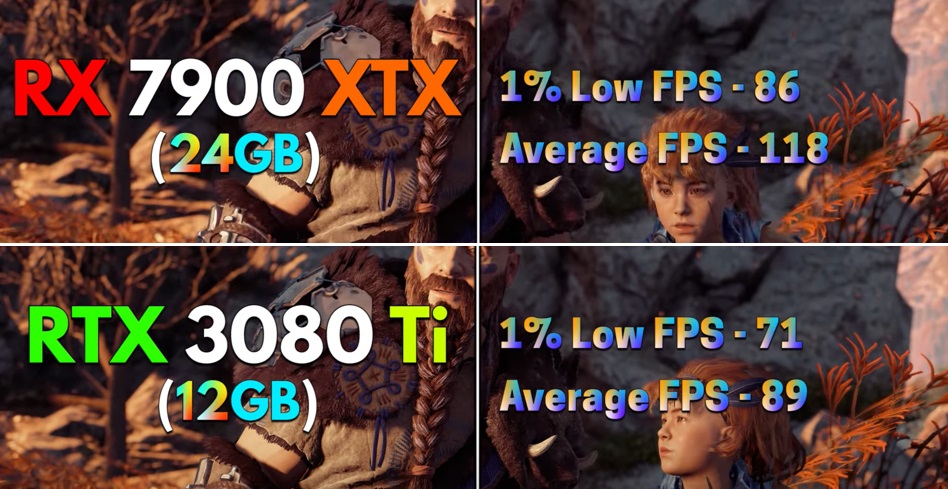
- The higher 2160p resolution was equally merciless on both GPUs. However, 7900 XTX manages to retain its lead by a margin of 28%.
- 7900 XTX was just shy of 2 fps from reaching the sweet 120 fps mark, averaging around 118 fps. 3080 Ti, on the other hand, could only yield 89 fps on average.
- 1% lows saw a much smaller difference of around 19%, this time in favor of 7900 XTX.
- It was able to deliver 86 fps in terms of 1% lows. 15 fps behind was 3080 Ti, delivering an average of 71 1% lows.
Watch Dogs Legion
Watch Dogs Legion is a perfect game to test our contenders, as it gets severely merciless on modern hardware due to its bad optimization.
1440p
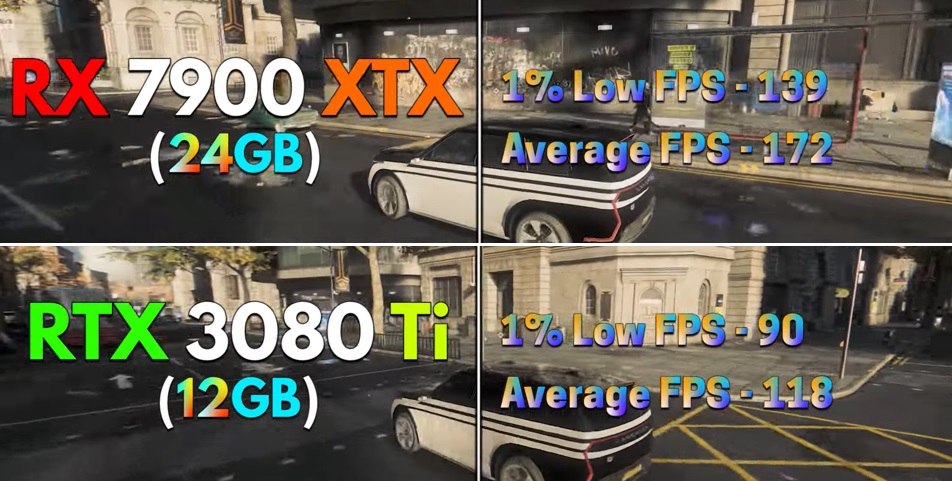
- Watch Dogs Legion clearly tends to prefer 7900 XTX over 3080 Ti, as the game ran 37% faster on it.
- 7900 XTX was able to deliver solid 172 fps on average. Next to that, the 3080 Ti was just two frames shy of a solid 120 fps experience and delivered 118 average fps.
- 1% lows saw a slightly bigger difference of around 42.7% in favor of 7900 XTX.
- It pushed out 139 frames when it came to 1% lows. 3080 Ti, on the other hand, was able to yield 90 fps in terms of 1% lows.
2160p
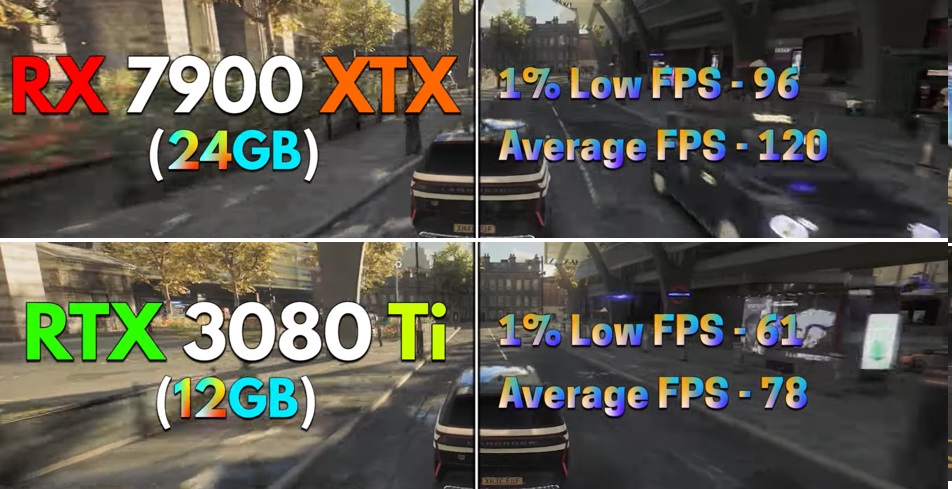
- At 2160p, the gap in average fps seems to have expanded to 42% in favor of 7900 XTX.
- It was now delivering a solid 120 fps experience. In comparison, the 3080 Ti could only run the game at an average of 78 fps.
- 1% lows saw a similar difference of 44%, with 7900 XTX coming on top.
- It managed to provide a respectable 96 1% low fps on average. 3080 Ti, on the other hand, was still 35 frames behind at 61 fps.
Call Of Duty Warzone 2
Call of Duty Warzone 2 is an extremely demanding title that tends to rely more on the GPU side. However, you will still need a beefy CPU to load those maps and textures on the spot.
1440p
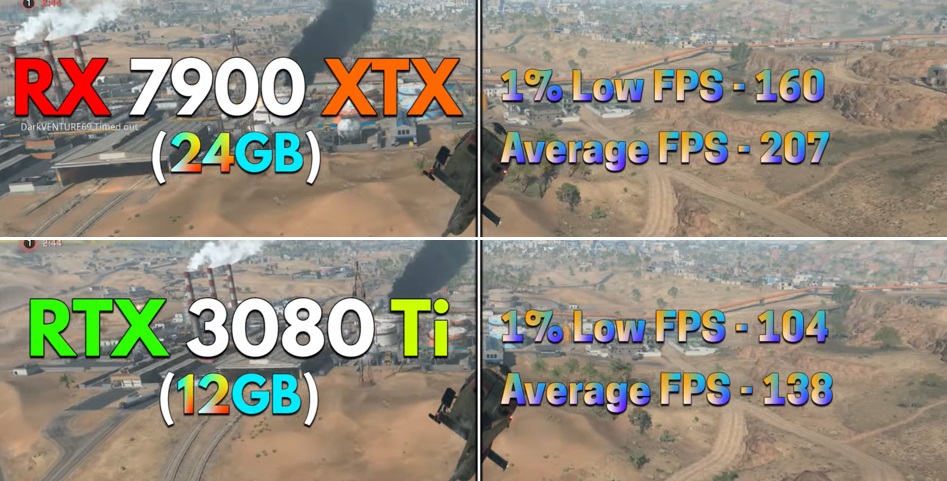
- Call of duty Warzone 2 ran extremely smoothly on 7900 XTX, crossing the 200 fps threshold and averaging around 207 fps.
- 3080 Ti struggled a little, as it was lagging with a difference of 40%, yielding an average of 138 fps.
- 1% lows saw a similar 42% difference, with 7900 XTX coming on top.
- It was able to deliver a whopping 160 fps in terms of 1% lows. Contrary to that, 3080 Ti was only able to offer 104 fps.
2160p
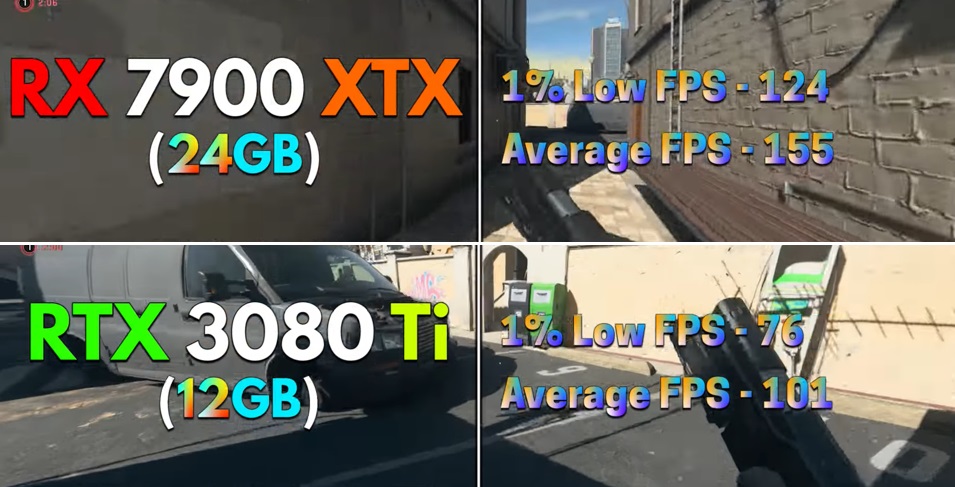
- The higher 2160p resolution was no different either, as 7900 XTX was still ahead with a respectable margin of 42.18%.
- It managed to run the game at an average of 155 fps. 3080 Ti severely struggled to catch up, as it was averaging around 101 fps.
- The game also ran much smoother on 7900 XTX, though, as it was a whopping 48% ahead in terms of 1% lows.
- 7900 XTX managed to deliver an average of 155 1% low fps. 3080 Ti had no chance of catching up, as it was only delivering 76 fps.
Hitman 3
Despite being better optimized than its predecessor, the latest title in the Hitman series can still give many GPUs a run for their money.
1440p
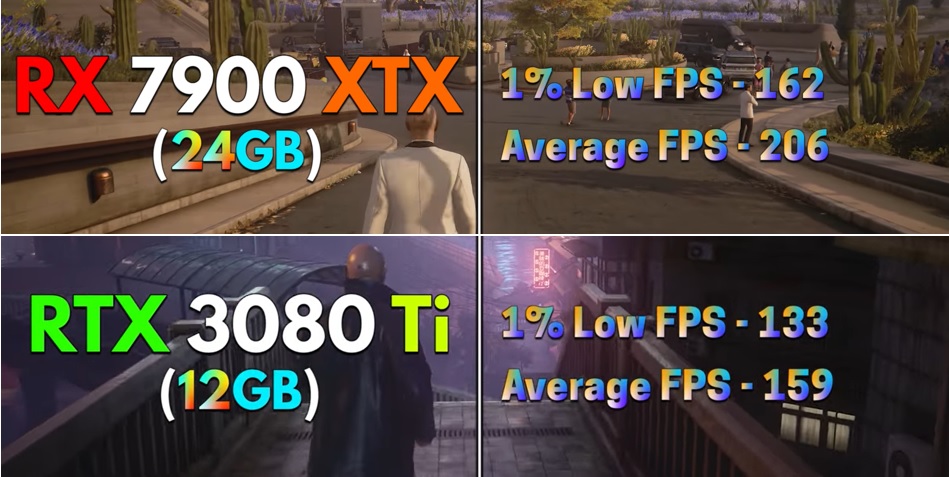
- Hitman 3 saw a below-average difference of around 25.7%, with 7900 XTX coming on top.
- It was steadily pushing out 206 fps on average. 3080 Ti could not quite keep up with this performance and maxed out on 159 average fps.
- The difference in 1% lows was smaller, as 7900 XTX performed 19.6% faster this time.
- On average, it was yielding 162 1% low fps. 29 frames behind was 3080 Ti hovering near 133 fps.
Also Read: RTX 4090 Vs RTX 3080 Ti
2160p
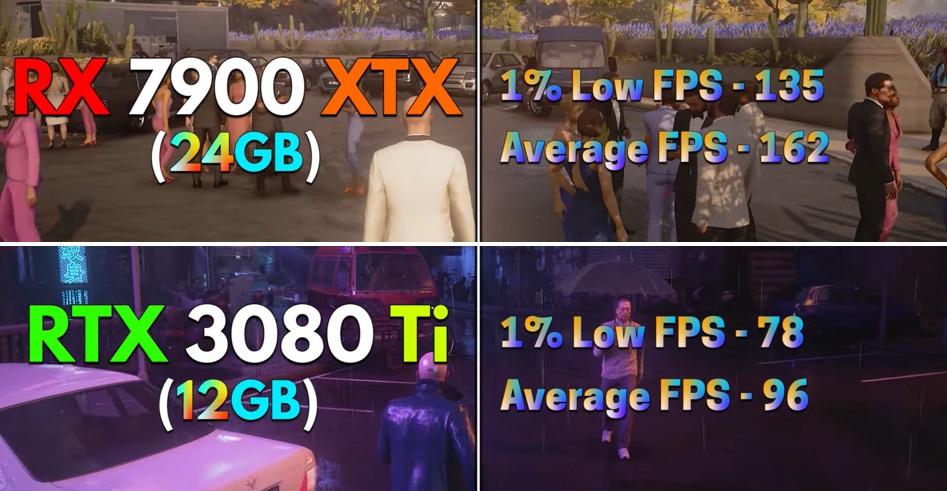
- The higher 2160p resolution was rather harsh on 3080 Ti, as it was now 51% behind 7900 XTX. This was one of the biggest differences observed throughout this benchmark.
- 7900 XTX ran the game comfortably at 162 fps. 3080 Ti, on the other hand, had no chance of keeping up as it even struggled to enter triple digits, averaging only around 96 fps.
- 7900 XTX extends its lead in terms of 1% lows by a whopping margin of 53.52%.
- It was averaging around 135 1% low fps this time around. 3080 Ti had no match against 7900 XTX, which maxed out at 1% lows of around 78 fps.
Call Of Duty Modern Warfare 2
Call of Duty Modern Warfare 2 is one of the very few games in this RX 7900 XTX vs RTX 3080 Ti gaming benchmarks that can actually utilize both a good GPU and CPU.
1440p
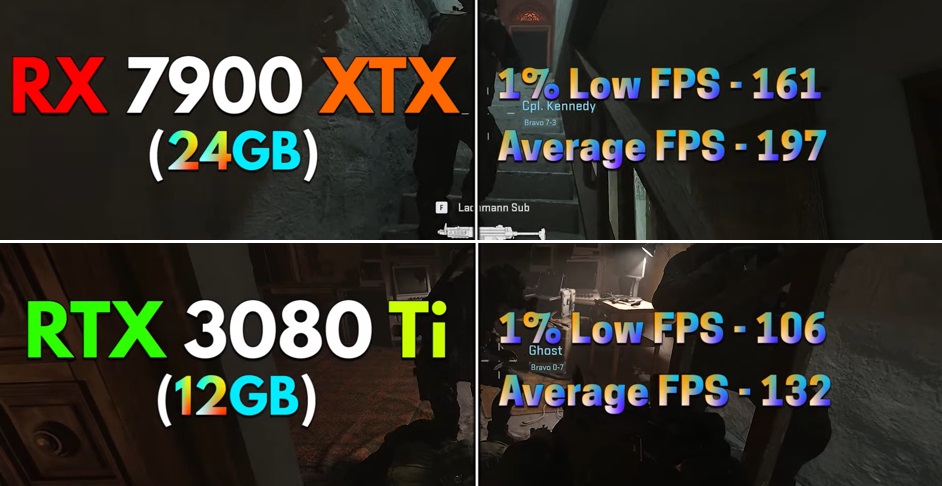
- After locking horns in Call of Duty Modern Warfare 2, 7900 XTX once again comes on top with a respectable margin of 40%.
- The average fps delivered by 7900 XTX lingered around 197 fps. Next to that, the 3080 Ti was able to yield 132 fps on average.
- 1% lows did not seem to paint a different picture either, as 7900 XTX was still 41% ahead of its competitor.
- It was still 55 fps ahead, averaging around 161 1% low fps. 3080 Ti, on the other hand, could only deliver an average of 106 fps.
2160p
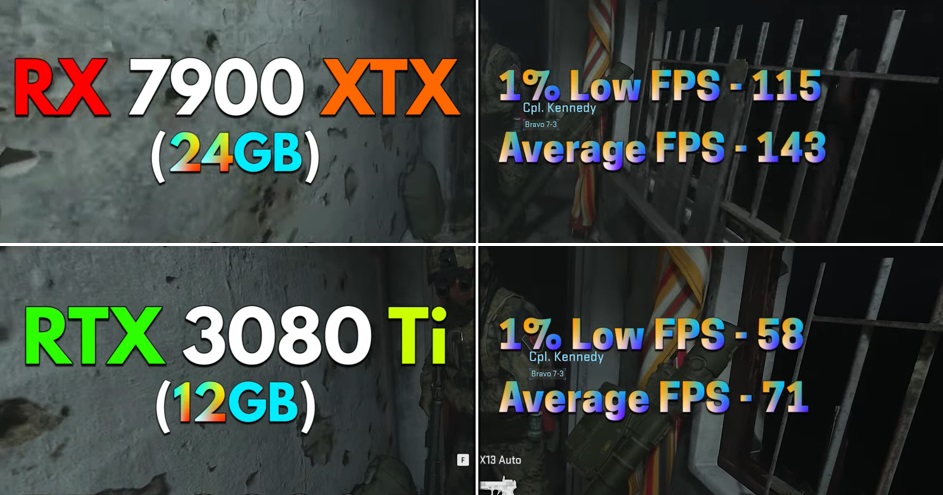
- 7900 XTX completely annihilates 3080 Ti in terms of average fps by a ground-breaking margin of 67%. This was the biggest difference observed so far in this benchmark.
- It manages to give an average of a respectable 143 fps. 3080 Ti had no chance of keeping up as it maxed out at 71 fps.
- The bashing continues for 3080 Ti, even in the 1% lows, as it is still 66% behind its competitor.
- 7900 XTX delivered an average of 115 fps when it came to 1% lows. In comparison to that, the 3080 Ti capped out at 58 fps.
Assassin’s Creed Valhalla
Being a Ubisoft title, Assassin’s Creed Valhalla does not have the best optimization, making it a perfect title for our competitor to lock horns in.
1440p
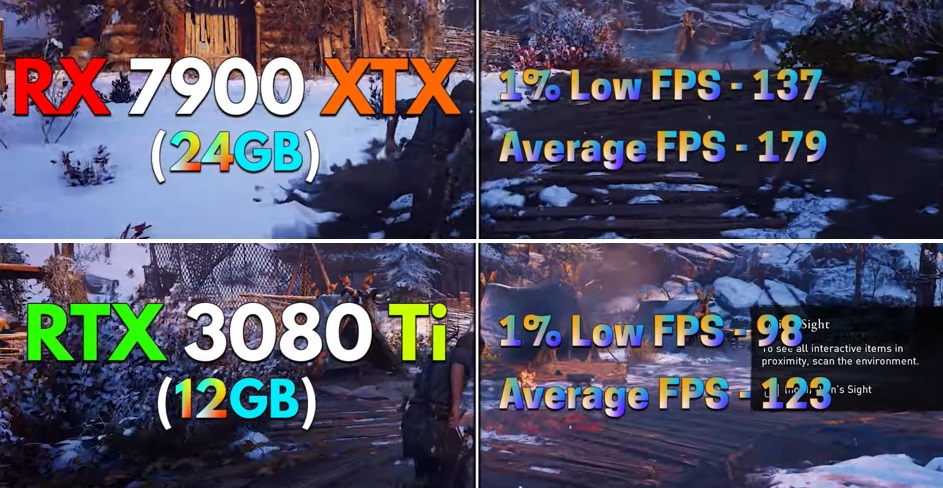
- The results from Assassin’s Creed Valhalla were no different either. 7900 XTX enjoys a considerable lead of 37% over its competitor in average fps.
- It provided a solid 179 fps on average compared to 123 average fps by 3080 Ti.
- 1% lows were roughly the same, with 7900 XTX coming on top once again by a margin of 33.19%.
- It pushed out 137 frames in terms of 1% lows. 3080 Ti, on the other hand, was just 2 frames shy of reaching triple digits, maxing out at 98 fps.
2160p
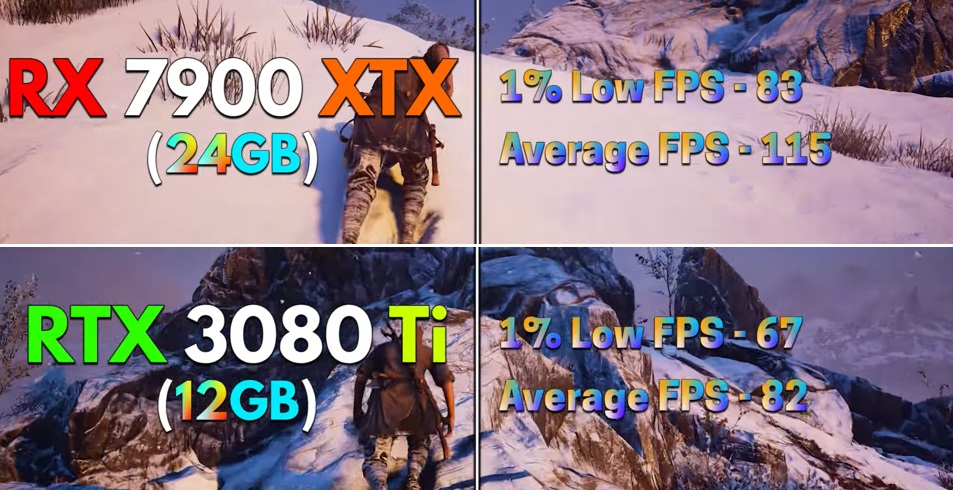
- The higher 2160p resolution was equally merciless on both GPUs, as the average fps have taken a significant hit. 7900 XTX still retains the lead by a margin of 33%.
- It delivered an average of 115 fps. 3080 Ti, this time, was 33 frames behind, averaging around 82 fps.
- To 3080 Ti’s credit, it did get closer in terms of 1%. However, 7900 XTX was still ahead, but by a smaller margin of 21% this time.
- It yielded 83 fps in terms of 1% lows, and not far behind was 3080 Ti, with an average of 67 fps.
Similar Comparison: i9-12900K vs Ryzen 9 5900X
Dying Light 2
Dying Light 2 is a newly released title that is equally merciless on CPU and GPU. The game is generally more demanding than other games we have tested in our RX 7900 XTX vs RTX 3080 Ti benchmarks.
1440p
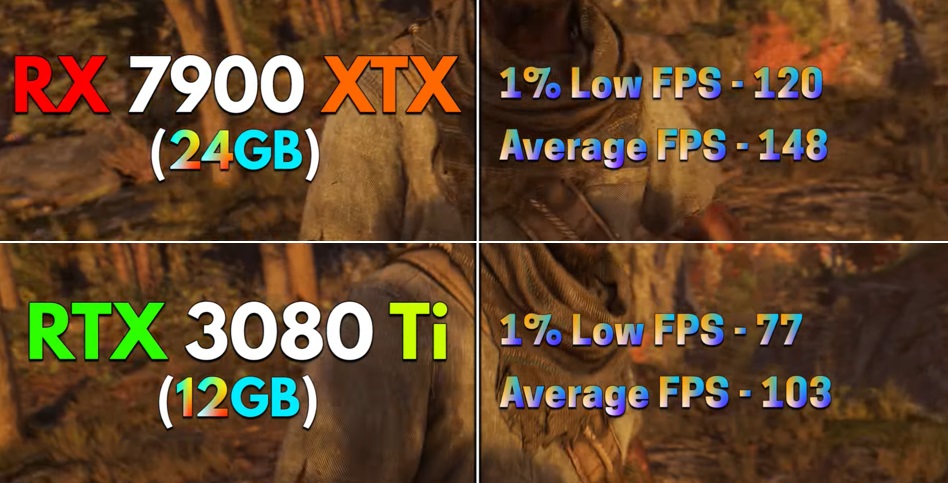
- As anticipated, Dying Light 2 prefers 7900 XTX over 3080 Ti, as the game ran 35% faster.
- 7900 XTX was able to run the game at 148 fps on average. 3080 Ti was severely struggling to catch up by averaging around 103 fps.
- 1% lows saw a bigger difference of around 43% in favor of 7900 XTX.
- It pushed out 120 1% low frames on average. 3080 Ti, on the other hand, could only yield 77 fps.
2160p
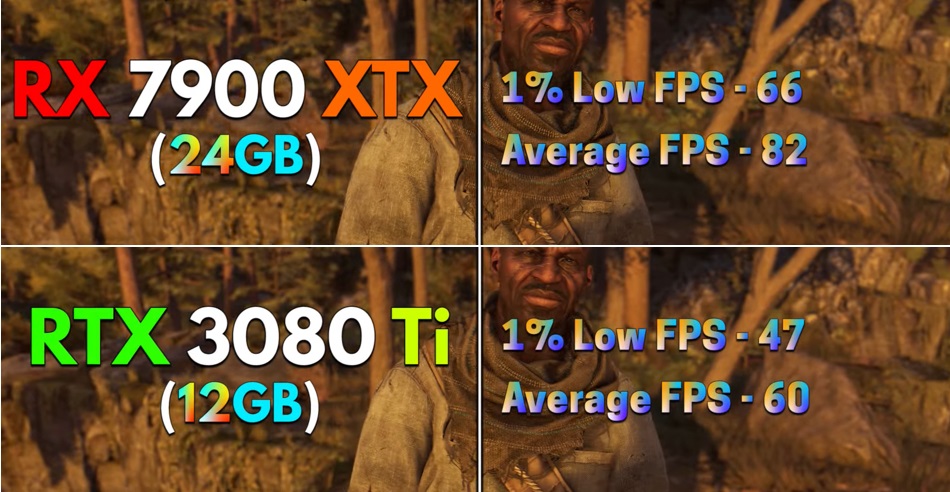
- 2160p is a little demanding, as both of our GPUs fall into double digits this time. 7900 XTX maintains a below-average victory of around 30% in average fps.
- It delivered an average of 82 fps, which is respectable at this demanding title on this resolution. 3080 Ti is also providing a stable 60 fps experience.
- 1% lows saw a similar difference of about 33%, with 7900 XTX coming ahead.
- The game ran slightly smoother on 7900 XTX, which yielded 66 fps in the 1% lows category. 3080 Ti, next to that, maxed out at 47 fps.
Far Cry 6
Far Cry 6 has major optimization issues. It relies heavily on the CPU’s cores and threads despite being a DirectX 12 title.
1440p
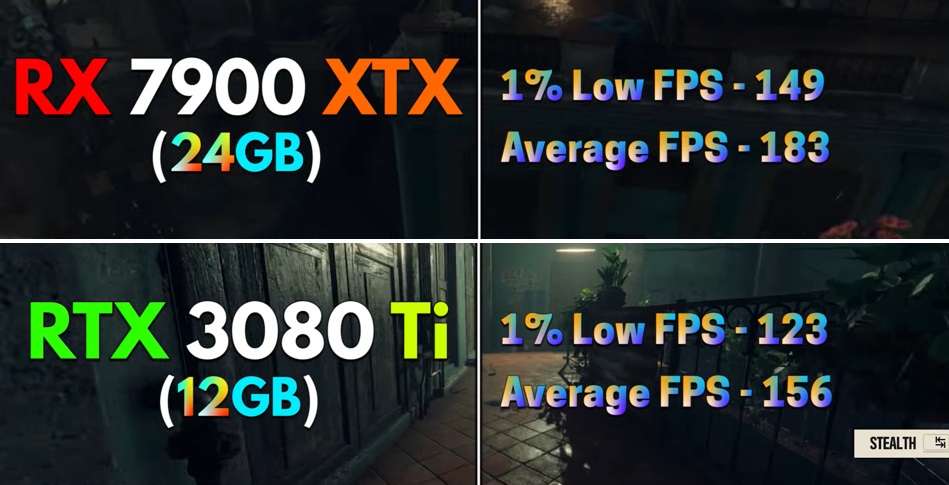
- To no one’s surprise, 7900 XTX leads our final benchmark by a margin of 15%. This is one of the smallest differences observed throughout this benchmark.
- The average fps yielded by 7900 XTX was hovering around 183. At the same time, the 3080 Ti was able to deliver 156 fps on average.
- Regarding 1% lows, 7900 XTX was averaging around 149 fps. Conversely, 3080 Ti delivered an average of 123 fps in 1% lows.
- The difference was bigger this time, with 7900 XTX coming on top with a margin of 19.1%.
2160p
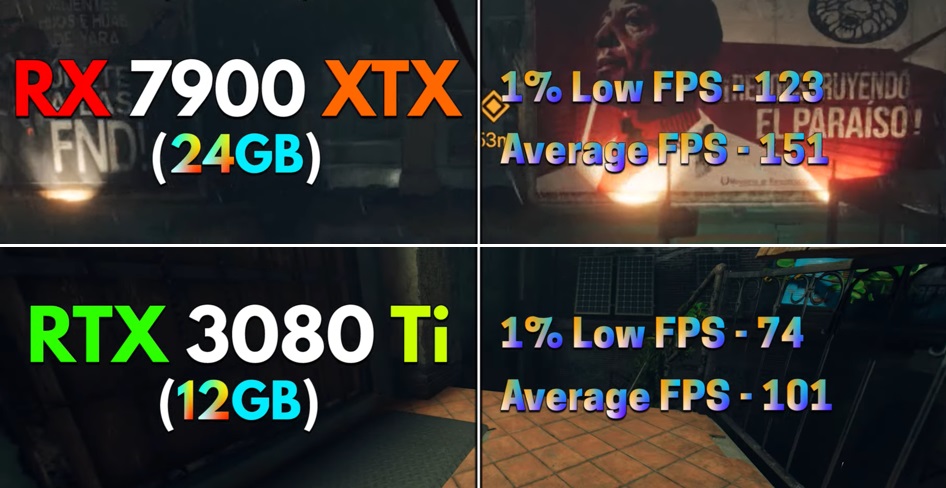
- The difference at the higher 2160p seems to have skyrocketed to 40% in favor of 7900 XTX.
- 7900 XTX crushed it by running the game at an average of 151 fps. 3080 Ti just managed to cross the 100 fps threshold, averaging around 101 fps.
- 1% lows yielded by 7900 XTX were around 123 fps compared to 74 fps by 3080 Ti.
- The margin in 1% lows was huge at 50%, with 7900 XTX coming on top.
Similar Comparisons: RTX 3080 Vs. 3080 Ti
RX 7900 XTX Vs RTX 3080 Ti: Overall Gaming Performance
From the RX 7900 XTX vs RTX 3080 Ti gaming benchmarks we have seen so far, it is safe to say that the Radeon RX 7900 XTX is anywhere between 25 to 51% better than Nvidia Geforce RTX 3080 Ti in games, depending on the game, resolution, and settings. Now, for a more in-depth analysis, we will take average fps, and 1% lows from the 9 titles tested and calculate their mean. This will give us a better estimate of how much performance difference we can generally expect between these GPUs.
1440p
Even though both of these GPUs were made for 4k gaming, the difference between them in 1440p was huge. 7900 XTX wiped the floor with a clear win in every title we tested today. 3080 Ti had no chance of catching up even though we were CPU bound in some games. This shows the dominance of 7900 XTX throughout the benchmark, that even at the lower resolutions where we are CPU bound, 7900 XTX will provide its users with an edge.
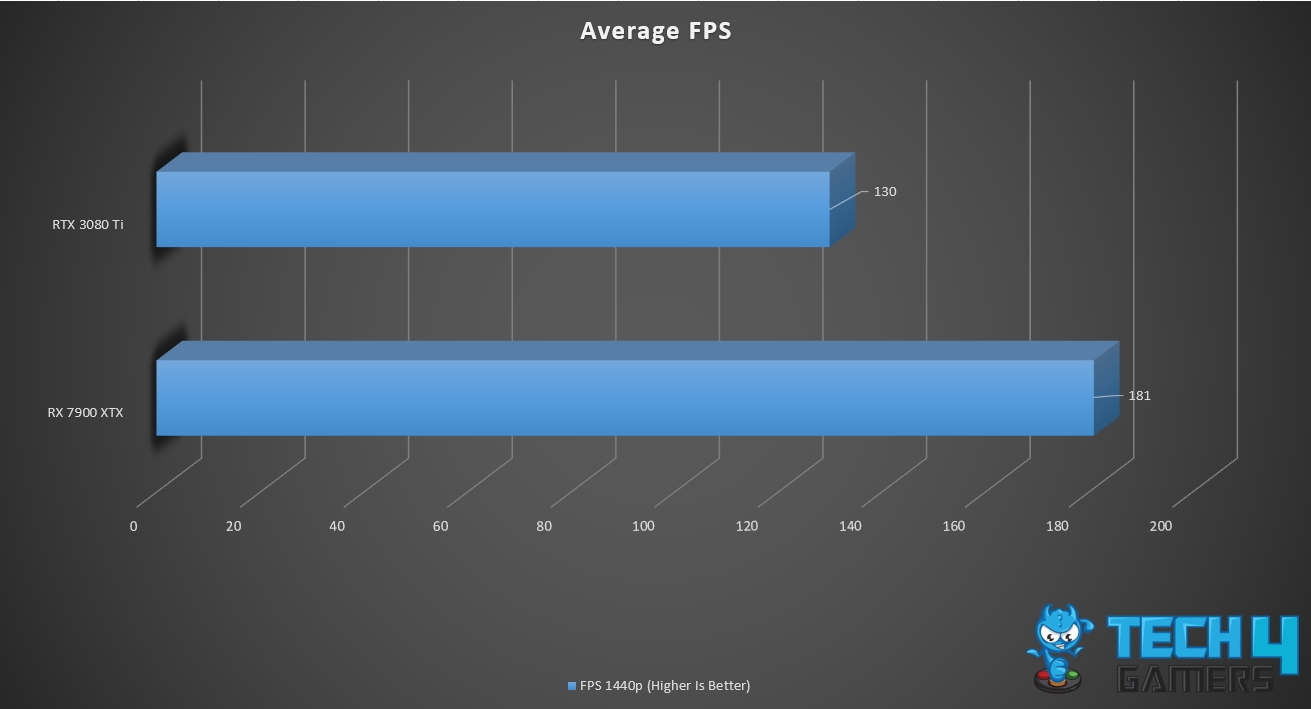
The biggest difference in average fps on 1440p resolution between these two GPUs was observed in Call of Duty Warzone 2 and Call of Duty Modern Warfare 2, where 7900 XTX was 40% better. At the same time, the smallest difference was observed in Far Cry 6, where 3080 Ti was only 15% behind.
2160p
As we move over to the higher resolutions, the load from the CPU gets taken off, and the GPU has to pay the price as games depend more on the GPU to render those frames at a higher resolution. The higher resolutions depict the performance differences more clearly between the two GPUs.
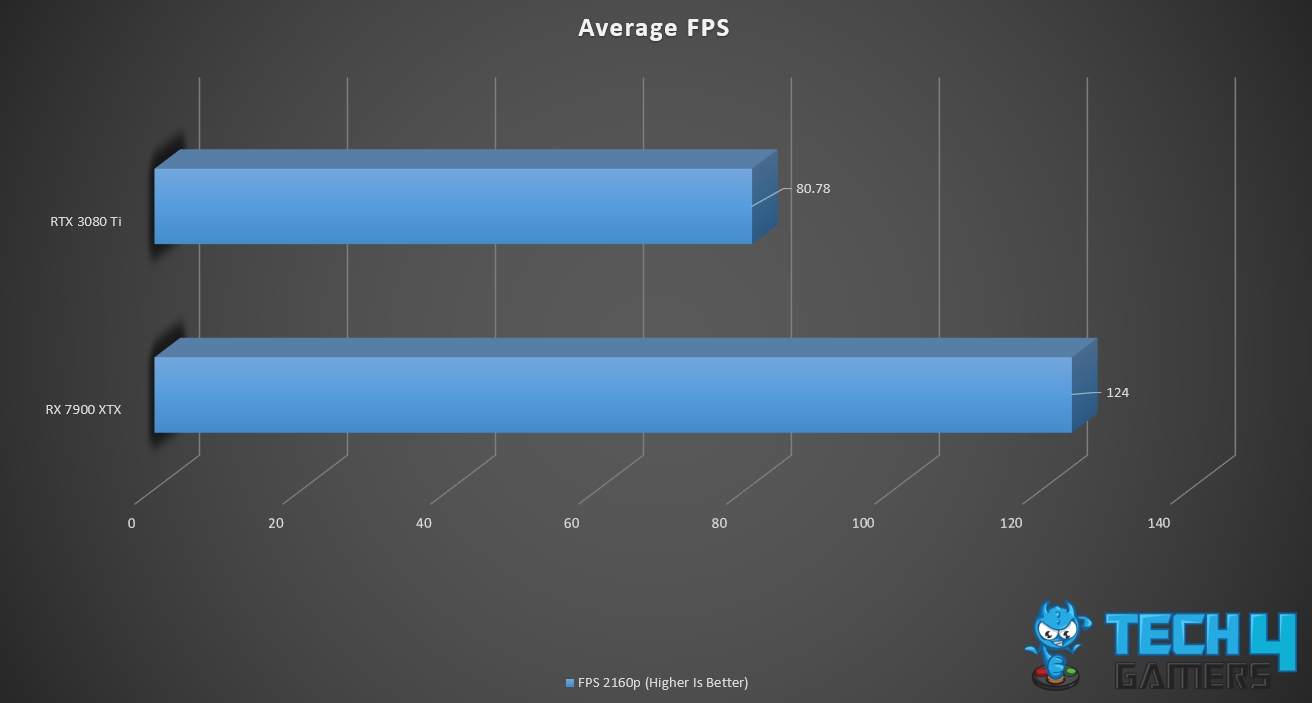
The biggest difference in average fps on 2160p resolution between these two GPUs was observed in Call of Duty Modern Warfare 2, where 7900 XTX was 67% better. The smallest difference was observed in Horizon Zero Dawn, where 3080 Ti was only 28% behind.
Power Consumption And Thermal Efficiency
Now, let’s take a look at the power consumption and thermal efficiency of RX 7900 XTX vs RTX 3080 Ti.
Total Power Draw
Power consumption is an important aspect to consider when buying a new GPU, especially if you are limited on budget and have a smaller PSU. In terms of power efficiency, both of these GPUs have a very similar TDP. RX 7900 XTX has a TDP of 355 watts. Exactly 5 watts lower is the TDP of RTX 3080 Ti at 350 watts. However, the suggested PSU for both GPUs is exactly 750 watts.
Now, in order to get a more realistic idea of the power consumption of both these GPUs, we will be calculating an average of total power drawn by our system during our gaming benchmarks so you can expect what type of PSU you need to pair with these GPUs. Keep in mind that both GPUs were running at the stock configuration, so if you are planning to overclock, you will have to get a bigger PSU.
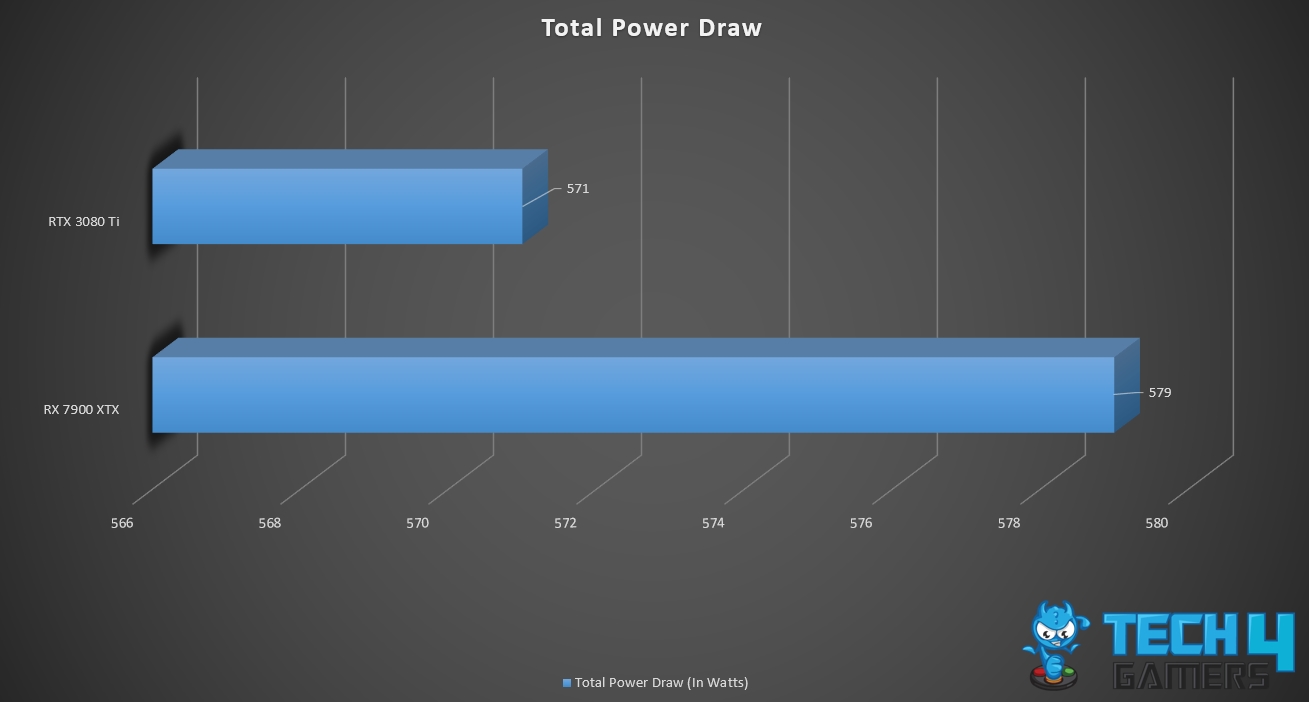
Thermal Efficiency
Thermals are another aspect to consider when buying a new GPU, especially if you live in a place with a warmer climate. The thermal efficiency of both these GPUs will depend greatly on the variant you buy and what type of fans it comes with. But for a rough estimate, we will be calculating the average of the temperatures these GPUs were running on during our benchmark and calculate the mean out of it. However, we do recommend taking this information with a grain of salt. As previously mentioned, every variant comes with a different set of fans, and the thermal efficiency will depend on it as well.
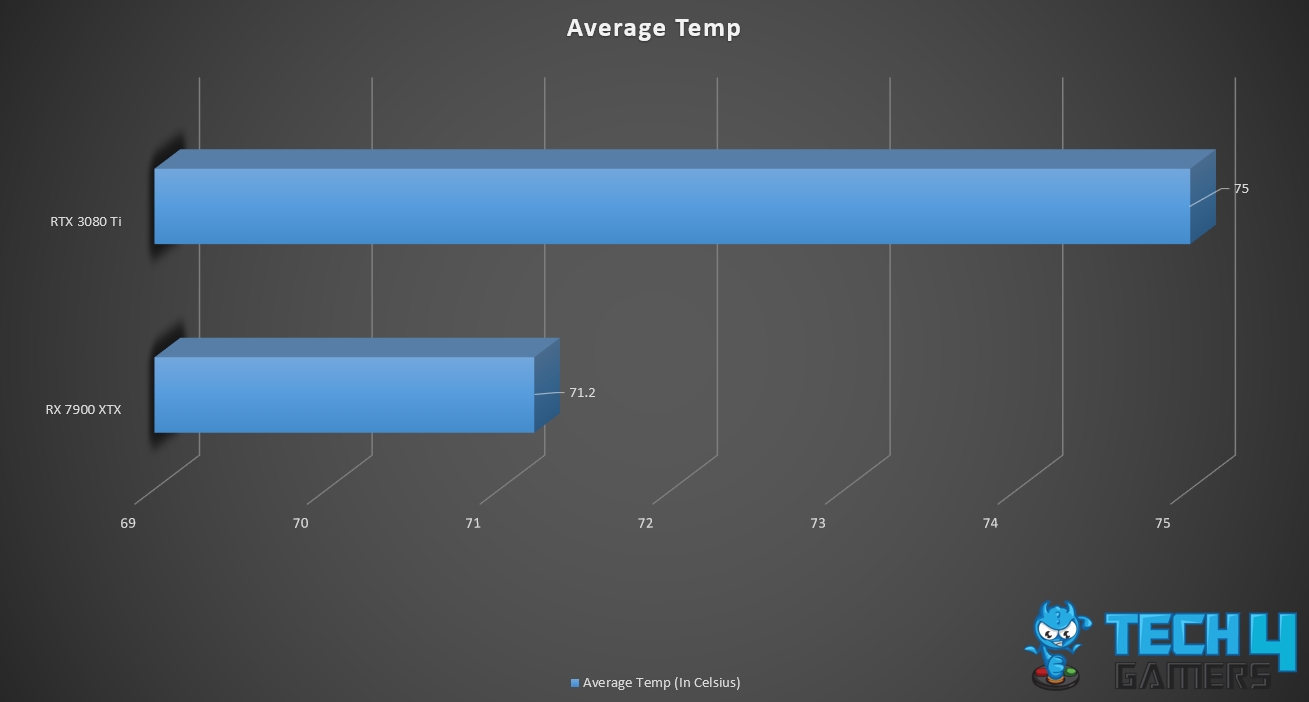
If your GPU does end up thermal throttling, then you might wanna check out our guide on how to lower GPU temperature.
Pricing And Availability
Perhaps the most important aspect to consider when you are limited on a budget but also looking for a GPU that can fulfill your needs is pricing. If we compare the MSRP of both GPUs, then we can easily say that the 7900 XTX is the better bang for the buck. It was released for a very competitive price of 999 USD, which ended up leaving shocks in the gaming community, especially after seeing the performance it was providing.
3080 Ti, on the other hand, was launched for 1199 USD, and it received a lot of criticism for that. However, it did end up selling well, and people readily bought it. But that’s because we were living in a pandemic, and people were buying anything that they could get their hands on. Based on the launch prices, the 7900 XTX is easily the better bang for the buck.
What’s worse is that, despite launching almost 2 years ago, the price of the 3080 Ti has not seen a significant drop, and at that price point, it is really hard to recommend it when there are so many better options available in the market.
Which One Should You Get?
AMD Radeon RX 7900 XTX and Nvidia Geforce RTX 3080 Ti are two of the best modern-day GPUs you can find in the market these days. They both are costing approximately the same these days and also require a similar PSU. However, which one you should get will depend greatly on your usage and requirement. If we look at it purely from a performance standpoint, then 7900 XTX will easily wipe the floor. It won every single one of our gaming benchmarks by respectable margins. It can provide anywhere between 20 to 50% more frames in games, depending on the game, resolution, and settings. All these perks while also being 18% cheaper. 7900 XTX also ran consistently cooler than 3080 Ti in almost every title we tested.
The only aspect where 3080 Ti outshines 7900 XTX is ray tracing and DLSS. 7900 XTX does come with FSR, which is AMD’s response to Nvidia’s DLSS. However, since it is an open-source technology, Nvidia cards, including 3080 Ti and others, will also get it. So, if ray tracing and DLSS are of priority for you, then going for 3080 Ti will make more sense. In any other case, 7900 XTX is easily the better deal. In any case, we hope that our RX 7900 XTX vs RTX 3080 Ti guide will help you make the right decision.
Frequently Asked Questions
AMD RX 7900 XTX performs 20 to 50% better in games as compared to Nvidia RTX 3080 Ti.
Both CPUs have a similar TDP and PSU requirement. However, 3080 Ti was consuming slightly less power.
7900 XTX is easily the better bang for the buck since it costs 18% less while also performing significantly better.
Also Read:
Thank you! Please share your positive feedback. 🔋
How could we improve this post? Please Help us. 😔
[Comparisons Expert]
Abdemanaf is a skilled creative writer who has been honing his craft since 2011. While initially working in different fields, he found a passion for technology and has been exploring the tech world since early 2015. Over the years, he has developed an in-depth knowledge of the latest tech trends and product offerings by various companies.
Abdemanaf’s writing reflects his analytical mindset and ability to think critically. He has a knack for breaking down complex technical information into easily digestible pieces, making his articles engaging and accessible to readers from all backgrounds. In February 2022, he joined Tech4Gamers as a blog and product comparison writer, where he has been able to hone his skills further.
As a writer, Abdemanaf is dedicated to staying up-to-date with the latest technological advancements and trends, enabling him to provide readers with the most relevant and accurate information. He is always eager to learn more and is constantly seeking new challenges to improve his skills.
Get In Touch: [email protected]


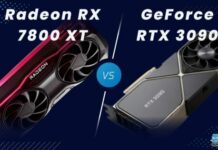
![Core i5-13600k Vs i5-12600K [We Tested 7 Games] Intel Core i5 13600k vs Intel Core i5 12600k](https://tech4gamers.com/wp-content/uploads/2022/11/Intel-Core-i5-13600k-vs-Intel-Core-i5-12600k-218x150.jpg)
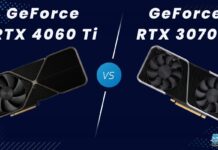
![Core i5-13400 Vs Ryzen 5 7600 [We Tested 9 Games] Core i5-13400 Vs Ryzen 5 7600](https://tech4gamers.com/wp-content/uploads/2023/04/Comparison-1-218x150.jpg)
![RTX 4070 Ti Vs RTX 3080 Ti [Gaming Benchmarks + Overall]](https://tech4gamers.com/wp-content/uploads/2023/01/RTX-4070-TI-VS-3TX-3080-TI-218x150.jpg)
